Important Message
This Website Terms and Condition of Use Agreement
also known as a 'terms of service agreement'
Will be at the bottom of most web pages!
Please read it before using this website.
Thank You
|
| The Mountain Man by Frederic Remington |
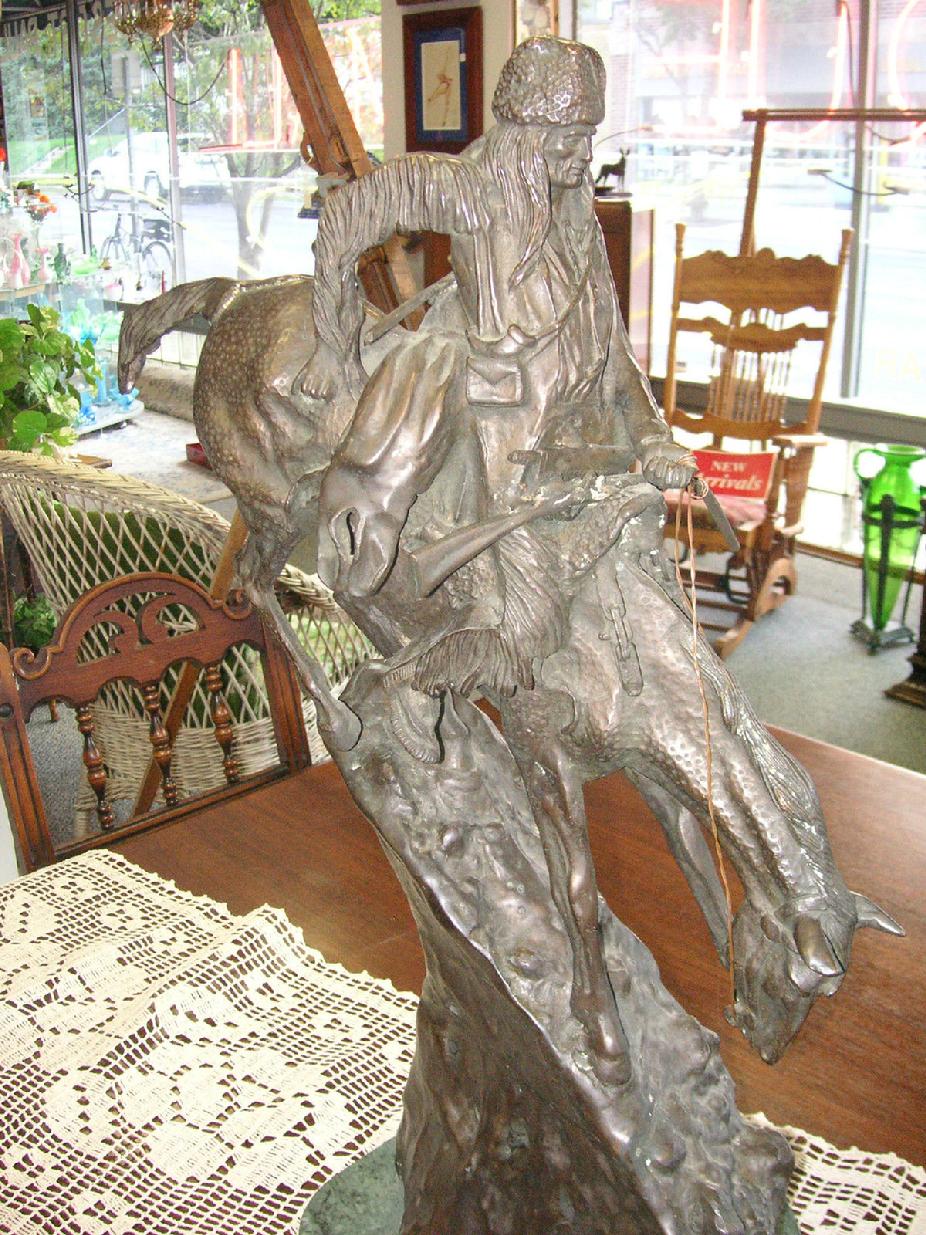 |
| The Mountain Man by Frederic Remington |
|
|
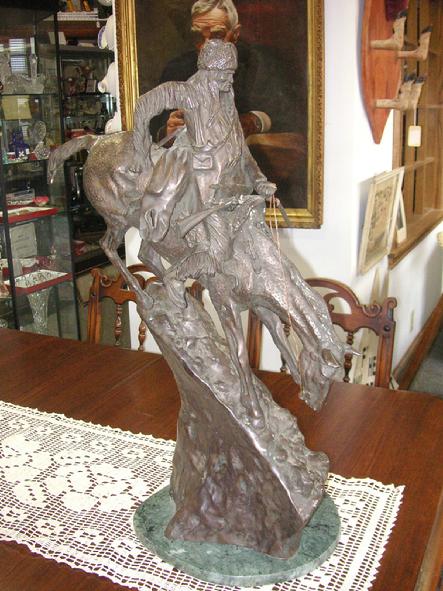 |
| The Mountain Man |
|
|
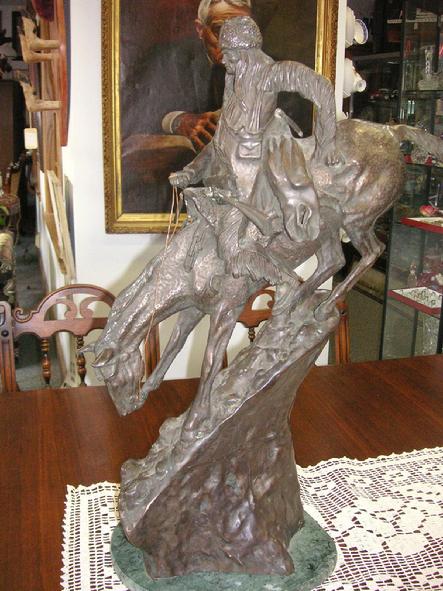 |
| by Frederic Remington |
|
|
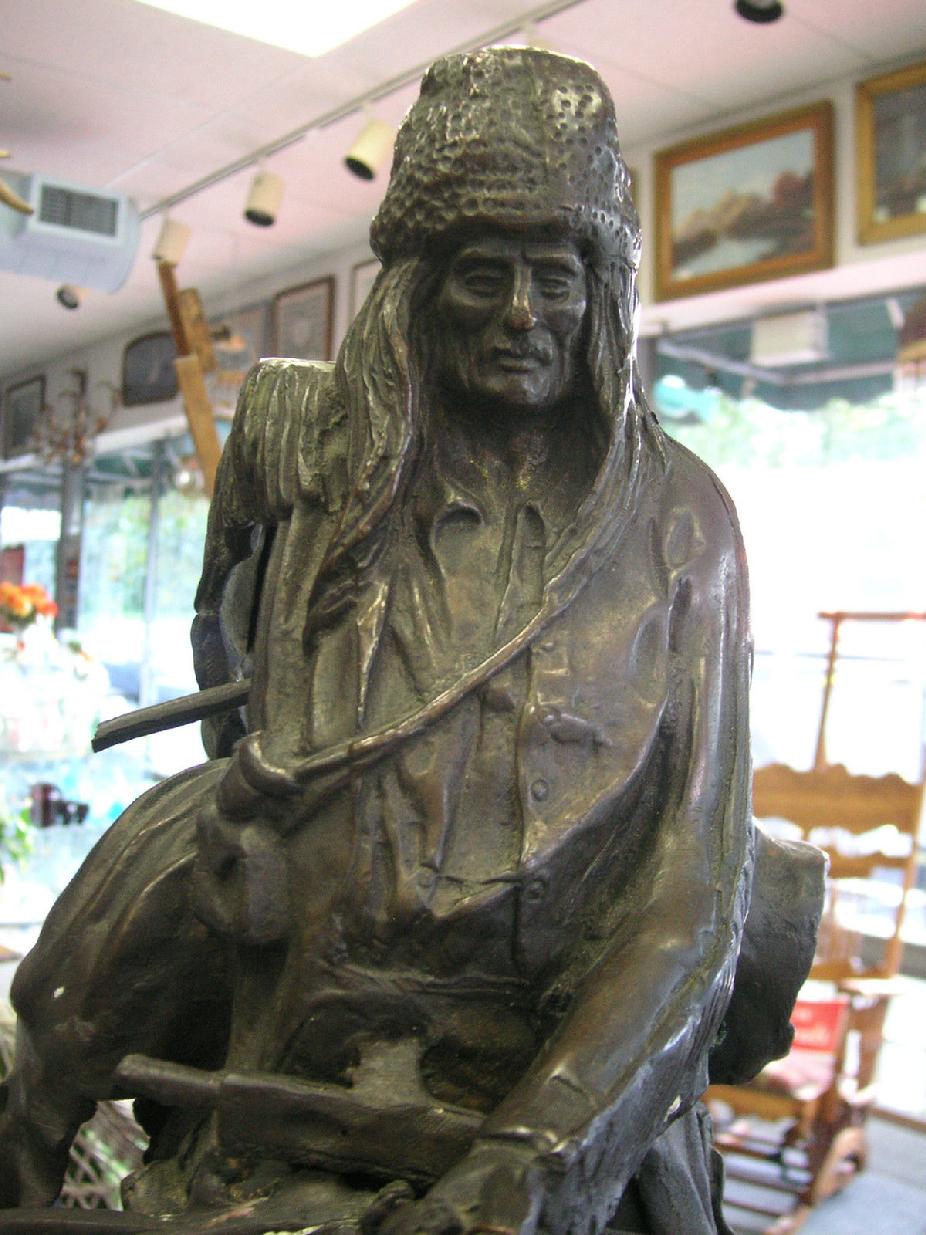 |
| The Mountain Man by Frederic Remington |
|
|
The Mountain Man
"Lost Wax"
Bronze Statue by Frederic Remington
The Mountain Man (1903). Remington described “The Mountain Man” as one of the "old Iroquois trappers who followed the Fur Companies in the Rocky Mountains in the 1830's & 40's," probably referring to French Canadian trappers. The sculptor chose a dramatic episode in the daily life of a trapper, his and his mount's descent on an almost vertical slope. Man and horse work together to make the trip down a treacherously rocky decline: The horse has been given full rein to choose its pace and path; the rider leans sharply back and balances himself by holding on to the tail strap with his right hand. Cast by Roman Bronze Works in the lost-wax technique, the earliest of The Mountain Man statuettes are sharply delineated with a rich variety of textures, particularly evident in the fringed buckskin garment, the animal's hairy hide, and the rocklike base. The base was cast separately from the horse and rider, and the two units are pinned together through the left hind and right fore hooves. Cast with the "Lost Wax Casting" process. Completed in 1885.
This statue is reproduced in solid bronze, cast in a brown patina and then hand-rubbed to bring out the incredible detail and highlights. The Mountain Man is a 27" high beautiful bronze statue by Remington with solid marble looking base. Over all measures approximately 27 inches high by 18 inches wide by 11 1/2 inches deep.
|
| Please scroll down to enjoy the many detailed photos below. |
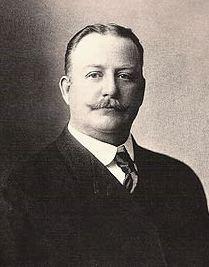 |
| Frederic Remington |
|
|
Frederic Sackrider Remington (October 4, 1861 – December 26, 1909) was an American painter, illustrator, sculptor, and writer who specialized in depictions of the Old American West, specifically concentrating on the last quarter of the 19th-century American West and images of cowboys, American Indians, and the U. S. Cavalry.
|
Remington was born in Canton, New York in 1861 to Seth Pierre Remington (1830–1880) and Clara Bascomb Sackrider, whose paternal family owned hardware stores and emigrated from Alsace-Lorraine in the early 18th century. Remington’s father was a colonel in the Civil War whose family arrived in the United States from England in 1637. He was a newspaper editor and postmaster, and the family was active in local politics and staunchly Republican. One of Remington’s great grandfathers, Samuel Bascom, was a saddle maker by trade, and the Remingtons were fine horsemen. Frederic Remington was related by family bloodlines to Indian portrait artist George Catlin and cowboy sculptor Earl W. Bascom.
Frederic Remington was also a cousin to Eliphalet Remington, founder of the Remington Arms Company which is considered to be America's oldest gunmaker. He was related, as well, to three famous mountain men - Jedediah S. Smith, Jonathan T. Warner and Robert "Doc" Newell. On the Warner side of his family, Frederic Remington was related to General George Washington, America's first president.
Colonel Remington was away at war during most of the first four years of his son's life. After the war, he moved his family to Bloomington, Illinois for a brief time and was appointed editor of the Bloomington Republican, but the family returned to Canton in 1867. Remington was the only child of the marriage, and received constant attention and approval. He was an active child, large and strong for his age, who loved to hunt, swim, ride, and go camping. He was a poor student, though, particularly in math, which did not bode well for his father's ambitions for his son to attend West Point. He began to make drawings and sketches of soldiers and cowboys at an early age.
The family moved to Ogdensburg, New York when Remington was eleven and he attended Vermont Episcopal Institute, a church-run military school, where his father hoped discipline would rein in his son's lack of focus, and perhaps lead to a military career. Remington took his first drawing lessons at the Institute. He then transferred to another military school where his classmates found the young Remington to be a pleasant fellow, a bit careless and lazy, good-humored, and generous of spirit, but definitely not soldier material.He enjoyed making caricatures and silhouettes of his classmates. At sixteen, he wrote to his uncle of his modest ambitions, "I never intend to do any great amount of labor. I have but one short life and do not aspire to wealth or fame in a degree which could only be obtained by an extraordinary effort on my part".He imagined a career for himself as a journalist, with art as a sideline.
Remington attended the art school at Yale University, studying under John Henry Niemeyer. Remington was the only male in the first year. He found that football and boxing were more interesting than the formal art training, particularly drawing from casts and still life objects. He preferred action drawing and his first published illustration was a cartoon of a "bandaged football player" for the student newspaper Yale Courant. Though he was not a star player, his participation on the strong Yale football team was a great source of pride for Remington and his family. He left Yale in 1879 to tend to his ailing father who had tuberculosis. His father died a year later, at age fifty, receiving respectful recognition from the citizens of Ogdensburg. Remington's Uncle Mart secured a good paying clerical job for his nephew in Albany, New York and Remington would return home on weekends to see his girlfriend Eva Caten. After the rejection of his engagement proposal to Eva by her father, Remington became a reporter for his Uncle Mart's newspaper, then went on to other short-lived jobs.
Living off his inheritance and modest work income, Remington refused to go back to art school and instead spent time camping and enjoying himself. At nineteen, he made his first trip west, going to Montana, at first to buy a cattle operation then a mining interest but realized he did not have sufficient capital for either. In the Ol' West of 1881, he saw the vast prairies, the quickly shrinking buffalo herds, the still unfenced cattle, and the last major confrontations of U.S. Cavalry and native American tribes, scenes he had imagined since his childhood. He also hunted grizzly bears with Montague Stevens in New Mexico in 1895. Though the trip was undertaken as a lark, it gave Remington a more authentic view of the West than some of the later artists and writers who followed in his footsteps, such as N. C. Wyeth and Zane Grey, who arrived twenty-five years later when the Ol' West had slipped into history. From that first trip, Harper's Weekly published Remington's first published commercial effort, a re-drawing of a quick sketch on wrapping paper that he had mailed back East. In 1883, Remington went to rural Peabody, Kansas, to try his hand at the booming sheep ranching and wool trade, as one of the "holiday stockmen", rich young Easterners out to make a quick killing as ranch owners. He invested his entire inheritance but Remington found ranching to be a rough, boring, isolated occupation which deprived him of the finer things of Eastern life, and the real ranchers thought of him as lazy.
|
Remington continued sketching but at this point his results were still cartoonish and amateur. After less than a year, he sold his ranch and went home. After acquiring more capital from his mother, he returned to Kansas City to start a hardware business, but due to an alleged swindle, it failed, and he reinvested his remaining money as a silent, half-owner of a saloon. He went home to marry Eva Caten in 1884 and they returned to Kansas City immediately. She was unhappy with his saloon life and was unimpressed by the sketches of saloon inhabitants that Remington regularly showed her. When his real occupation became known, she left him and returned to Ogdensburg. With his wife gone and with business doing badly, Remington started to sketch and paint in earnest, and bartered his sketches for essentials.
He soon had enough success selling his paintings to locals to see art as a real profession. Remington returned home again, his inheritance gone but his faith in his new career secured, reunited with his wife and moved to Brooklyn. He began studies at the Art Students League of New York and significantly bolstered his fresh though still rough technique. His timing was excellent as newspaper interest in the dying West was escalating. He submitted illustrations, sketches, and other works for publication with Western themes to Collier's and Harper's Weekly, as his recent Western experiences (highly exaggerated) and his hearty, breezy "cowboy" demeanor gained him credibility with the eastern publishers looking for authenticity. His first full page cover under his own name appeared in Harper's Weekly on January 9, 1886, when he was twenty-five. With financial backing from his Uncle Bill, Remington was able to pursue his art career and support his wife.
In 1886, Remington was sent to Arizona by Harper's Weekly on a commission as an artist-correspondent to cover the government's war against Geronimo. Although he never caught up with Geronimo, Remington did acquire many authentic artifacts to be used later as props, and made many photos and sketches valuable for later paintings. He also made notes on the true colors of the West, such as "shadows of horses should be a cool carmine & Blue", to supplement the black-and-white photos. Ironically, art critics later criticized his palette as "primitive and unnatural" even though it was based on actual observation.
After returning East, Remington was sent by Harper's Weekly to cover the Charleston, South Carolina earthquake of 1886. To expand his commission work, he also began doing drawings for Outing magazine. His first year as a commercial artist had been successful, earning Remington $1,200, almost triple that of a typical teacher. He had found his life's work and bragged to a friend, "That's a pretty good break for an ex cow-puncher to come to New York with $30 and catch on it 'art'."
For commercial reproduction in black-and-white, he produced ink and wash drawings. As he added watercolor, he began to sell his work in art exhibitions. His works were selling well but garnered no prizes, as the competition was strong and masters like Winslow Homer and Eastman Johnson were considered his superiors. A trip to Canada in 1887, produced illustrations of the Blackfoot, the Crow Nation, and the Canadian Mounties, eagerly enjoyed by the reading public.
Later that year, Remington received a commission to do eighty-three illustrations for a book by Theodore Roosevelt, Ranch Life and the Hunting Trail, to be serialized in The Century Magazine before publication. The 29-year-old Roosevelt had a similar Western adventure to Remington, losing money on a ranch in North Dakota the previous year but gaining experience which made him an "expert" on the West. The assignment gave Remington's career a big boost and forged a lifelong connection with Roosevelt.
His full-color oil painting Return of the Blackfoot War Party was exhibited at the National Academy of Design and the New York Herald commented that Remington would "one day be listed among our great American painters". Though not admired by all critics, Remington's work was deemed "distinctive" and "modern". By now, he was demonstrating the ability to handle complex compositions with ease, as in Mule Train Crossing the Sierras (1888), and to show action from all points of view His status as the new trendsetter in Western art was solidified in 1889 when he won a second-class medal at the Paris Exposition. He had been selected by the American committee to represent American painting, over Albert Bierstadt whose majestic, large-scale landscapes peopled with tiny figures of pioneers and Indians was now considered passé.
Around this time, Remington made a gentleman's agreement with Harper's Weekly, giving the magazine an informal first option on his output but maintaining Remington's independence to sell elsewhere if desired. As a bonus, the magazine launched a massive promotional campaign for Remington, stating that "He draws what he knows, and he knows what he draws." Though laced with blatant puffery (common for the time) claiming that Remington was a bona fide cowboy and Indian scout, the effect of the campaign was to raise Remington to the equal of the era's top illustrators, Howard Pyle and Charles Dana Gibson.
His first one-man show, in 1890, presented twenty-one paintings at the American Art Galleries and was very well received. With success all but assured, Remington became established in society. His personality, his "pseudo-cowboy" speaking manner, and "Wild West" reputation were strong social attractions. His biography falsely promoted some of the myths he encouraged about his Western experiences.
Remington's regular attendance at celebrity banquets and stag dinners, however, though helpful to his career, fostered prodigious eating and drinking which caused his girth to expand alarmingly. Obesity became a constant problem for him from then on. Among his urban friends and fellow artists, he was "a man among men, a deuce of a good fellow" but notable because he (facetiously) "never drew but two women in his life, and they were failures" (not counting Indian women).
In 1890, Remington and his wife moved to New Rochelle, New York in order to have both more living space and extensive studio facilities, and also with the hope of gaining more exercise. The community was close to New York City affording easy access to the publishing houses and galleries necessary for the artist, and also rural enough to provide him with the space he needed for horseback riding, and other physical activities that relieved the long hours of concentration required by his work. Moreover, an artists' colony had developed in the town, so that the Remingtons counted among their neighbor's writers, actors, and artists such as Francis Wilson, Julian Hawthorne, Edward Kemble, and Augustus Thomas.
The Remington's substantial Gothic revival house was situated at 301 Webster Avenue, on a prestigious promontory known as "Lathers Hill". A sweeping lawn rolled south toward Long Island Sound, providing views on three sides of the beautiful Westchester County countryside. Remington called it “Endion", an Ojibwa word meaning "the place where I live." In the early years, no real studio existed at "Endion" and Remington did most of his work in a large attic under the home's front gable where he stored materials collected on his many western excursions. Later he used his library on the main floor, a larger, more comfortable room that soon took on the cluttered appearance of an atelier. However, neither situation was completely satisfactory: the space was limited, the light was less than adequate, and the surroundings were generally uninspiring. In the spring of 1896 Remington retained the New Rochelle architect O. William Degen to plan a studio addition to the house. An article in the New Rochelle Pioneer of April 26 touted the "fine architectural design" of the studio. Remington himself wrote to his friend the novelist Owen Wister:
Have concluded to build a butler's pantry and a studio (Czar size) on my house—we will be torn [up] for a month and then will ask you to come over—throw your eye on the march of improvement and say this is a great thing for American art. The fireplace is going to be like this.—Old Norman house—Big—big.
|
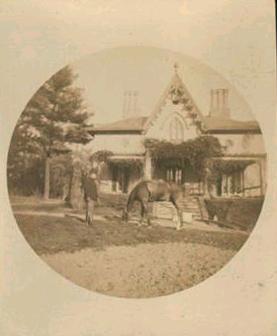 |
| Remington estate 'Endion' in New Rochelle, New York. The Gothic-revival cottage was designed by Alexander J. Davis. |
|
|
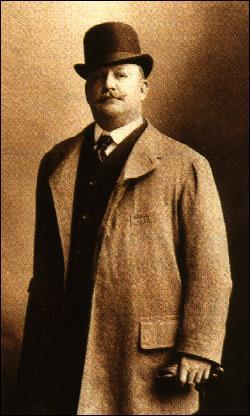 |
| Frederic Remington |
|
|
| Born |
Frederic Sackrider Remington
(1861-10-04)October 4, 1861
Canton, New York |
|---|
| Died |
December 26, 1909(1909-12-26) (aged 48)
Ridgefield, Connecticut |
|---|
| Education |
Yale University, New Haven, Connecticut, one drawing class, 1878;
Art Students League, New York, 1886 |
|---|
| Known for |
Painting (watercolor and oil), sculpture, drawing (pen and ink, ink wash), and mixed media |
|---|
| Notable work(s) |
Amon Carter Museum, Fort Worth, Texas; Buffalo Bill Historical Center, Cody, Wyoming; Gilcrease Museum, Tulsa, Oklahoma; Metropolitan Museum, New York City; Museum of Fine Arts, Houston; Frederic Remington Art Museum, Ogdensburg, New York; National Cowboy & Western Heritage Museum, Oklahoma City, Oklahoma; and others |
|---|
| Movement |
Illustration, Impressionism, Nocturne, and Tonalism |
|---|
| Spouse(s) |
Eva Caten (1884–1909) |
|---|
| Awards |
1891: Elected Associate of the National Academy of Design (ANA) |
|---|
|
| Patron(s) |
Theodore Roosevelt, Elizabeth Custer, Harper's Weekly, Harper's Monthly, Century Magazine, Scribner's, Cosmopolitan, Collier's, and many others. |
|---|
|
Remington's fame made him a favorite of the Western Army officers fighting the last Indian battles. He was invited out West to make their portraits in the field and to gain them national publicity through Remington's articles and illustrations for Harper's Weekly, particularly General Nelson Miles, an Indian fighter who aspired to the presidency of the United States. In turn, Remington got exclusive access to the soldiers and their stories and boosted his reputation with the reading public as "The Soldier Artist". One of his 1889 paintings depicts eight cavalrymen shooting at Apaches in the rear as they attempt to outrun the Indians. Another painting that year depicts cavalrymen in an Arizona sandstorm. Remington wrote that the "heat was awful and the dust rose in clouds. Men get sulky and go into a comatose state – the fine alkali dust penetrates everything but the canteens."
Remington arrived on the scene just after the 1890 massacre at Wounded Knee, South Dakota, in which 150 Sioux, mostly women and children, were killed. He reported the event as "The Sioux Outbreak in South Dakota", having hailed the Army's "heroic" actions toward the Indians. Some of the Miles paintings are monochromatic and have an almost "you-are-there" photographic quality, heightening the realism, as in The Parley (1898)
Remington's Self-Portrait on a Horse (1890) shows the artist as he wished he was, not the pot-bellied Easterner weighing heavily on a horse, but a tough, lean cowboy heading for adventure with his trusty steed. It was the image his publishers worked hard to maintain as well. In His Last Stand (1890), a cornered bear in the middle of a prairie is brought down by dogs and riflemen, which may have been a symbolized treatment of the dying Indians he had witnessed. Remington's attitude toward Native Americans was typical for the time. He thought them unfathomable, fearless, superstitious, ignorant, and pitiless—and generally portrayed them as such. White men under attack were brave and noble.
Through the 1890s, Remington took frequent trips around the U.S., Mexico, and abroad to gather ideas for articles and illustrations, but his military and cowboy subjects always sold the best, even as the Old West was playing out. In 1892, he painted "A Cavalryman's Breakfast on the Plains". Gradually, he transitioned from the premiere chronicler-artist of the Old West to its most important historian-artist. He formed an effective partnership with Owen Wister, who became the leading writer of Western stories at the time. Having more confidence of his craft, Remington wrote, "My drawing is done entirely from memory. I never use a camera now. The interesting never occurs in nature as a whole, but in pieces. It's more what I leave out than what I add." Remington's focus continued on outdoor action and he rarely depicted scenes in gambling and dance halls typically seen in Western movies. He avoided frontier women as well. His painting A Misdeal (1897) is a rare instance of indoor cowboy violence.
Remington's had developed a sculptor's 360-degree sense of vision but until a chance remark by playwright Augustus Thomas in 1895, Remington had not yet conceived of himself as a sculptor and thought of it as a separate art for which he had no training or aptitude. With help from friend and sculptor Frederick Ruckstull, Remington constructed his first armature and clay model, a "broncho buster" where the horse is reared on its hind legs—technically a very challenging subject. After several months, the novice sculptor overcame the difficulties and had a plaster cast made, then bronze copies, which were sold at Tiffany's. Remington was ecstatic about his new line of work, and though critical response was mixed, some labelling it negatively as "illustrated sculpture", it was a successful first effort earning him $6,000 over three years.
During that busy year, Remington became further immersed in military matters, inventing a new type of ammunition carrier; but his patented invention was not accepted for use by the War Department. His favorite subject for magazine illustration was now military scenes, though he admitted, "Cowboys are cash with me". Sensing the political mood of that time, he was looking forward to a military conflict which would provide the opportunity to be a heroic war correspondent, giving him both new subject matter and the excitement of battle. He was growing bored with routine illustration, and he wrote to Howard Pyle, the dean of American illustrators, that he had "done nothing but potboil of late". (Earlier, he and Pyle in a gesture of mutual respect had exchanged paintings—Pyle's painting of a dead pirate for Remington's of a rough and ready cowpuncher). He was still working very hard, spending seven days a week in his studio.
Remington was further irritated by the lack of his acceptance to regular membership by the Academy, likely because of his image as a popular, cocky, and ostentatious artist. Remington kept up his contact with celebrities and politicos, and continued to woo Theodore Roosevelt, now the New York City Police Commissioner, by sending him complimentary editions of new works. Despite Roosevelt's great admiration for Remington, he never purchased a Remington painting or drawing
|
The Mountain Man
The Original is displayed in Washington D.C.
|
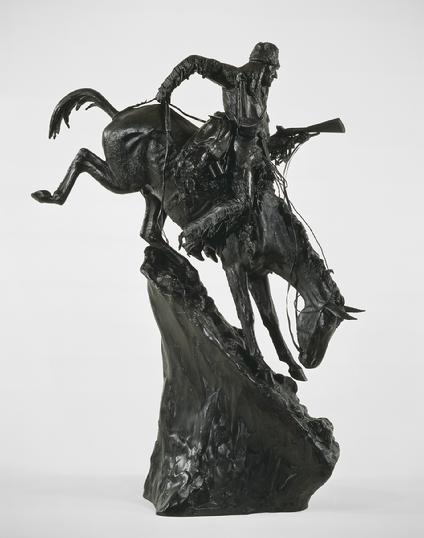 |
| 1903 The Mountain Man, a sculpture by Frederic Remington. |
|
|
Sculpture exhibited in the Corcoran Gallery of Art,
Washington, D.C.
There were no prohibitions against photography in the museum.
This artwork is in the public domain
because it was first published in
the United States before 1923.
Date 0f photo: June 15th, 2012
|
Remington's association with Roosevelt paid off, however, when the artist became a war correspondent and illustrator during the Spanish-American War in 1898, sent to provide illustrations for William Randolph Hearst's New York Journal. He witnessed the assault on San Juan Hill by American forces, including those led by Roosevelt. However, his heroic conception of war, based in part on his father's Civil War experiences, were shattered by the actual horror of jungle fighting and the deprivations he faced in camp. His reports and illustrations upon his return focused not on heroic generals but on the troops, as in his Scream of the Shrapnel (1899), which depicts a deadly ambush on American troops by an unseen enemy. When the Rough Riders returned to the U.S., they presented their courageous leader Roosevelt with Remington's bronze statuette, The Broncho Buster, which the artist proclaimed, "the greatest compliment I ever had…After this everything will be mere fuss." Roosevelt responded, "There could have been no more appropriate gift from such a regiment."
In 1888, he achieved the public honor of having two paintings used for reproduction on U. S. Postal stamps. In 1900, as an economy move, Harper's dropped Remington as their star artist. To compensate for the loss of work, Remington wrote and illustrated a full-length novel, The Way of an Indian, which was intended for serialization by a Hearst publication but not published until five years later in Cosmopolitan. Remington's protagonist, a Cheyenne named Fire Eater, is a prototype Native American as viewed by Remington and many of his time.
Remington then returned to sculpture, and produced his first works produced by the lost wax method, a higher quality process than the earlier sand casting method he had employed. By 1901, Collier's was buying Remington's illustrations on a steady basis. As his style matured, Remington portrayed his subjects in every light of day. His nocturnal paintings, very popular in his late life, such as A Taint on the Wind and Scare in the Pack Train, are more impressionistic and loosely painted, and focus on the unseen threat.
Remington completed another novel in 1902, John Ermine of the Yellowstone, a modest success but a definite disappointment as it was completely overshadowed by the best seller The Virginian, written by his sometime collaborator Owen Wister, which became a classic Western novel. A stage play based on "John Ermine" failed in 1904. After "John Ermine", Remington decided he would soon quit writing and illustration (after drawing over 2700 illustrations) to focus on sculpture and painting.
In 1903, Remington painted His First Lesson set on an American-owned ranch in Chihuahua, Mexico. The hands wear heavy chaps, starched white shirts, and slouch-brimmed hats. In his paintings, Remington sought to let his audience "take away something to think about – to imagine." The Mountain Man, a sculpture created by Remington in 1903 and in 1905, Remington had a major publicity coup when Collier's devoted an entire issue to the artist, showcasing his latest works. It was that same year that the president of the Fairmount Park Art Association (now the Association for Public Art) commissioned Remington to create a large sculpture of a cowboy for Philadelphia's Fairmount Park, which was erected in 1908 on a jutting rock along Kelly Drive – a site Remington specifically chose for the piece after having a horseman pose for him in that exact location. Philadelphia's Cowboy (1908) was Remington's first and only large-scale bronze, and the sculpture is one of the earliest examples of site-specific art in the United States.
Remington's "Explorers" series, depicting older historical events in western U.S. history, did not fare well with the public or the critics. The financial panic of 1907 caused a slow down in his sales and in 1908, fantasy artists, such as Maxfield Parrish, became popular with the public and with commercial sponsors. Remington tried to sell his home in New Rochelle to get further away from urbanization. One night he made a bonfire in his yard and burned dozens of his oil paintings which had been used for magazine illustration (worth millions of dollars today), making an emphatic statement that he was done with illustration forever. He wrote, "there is nothing left but my landscape studies". Near the end of his life, he moved to Ridgefield, Connecticut. In his final two years, under the influence of The Ten, he was veering more heavily to Impressionism, and he regretted that he was studio bound (by virtue of his declining health) and could not follow his peers who painted "plein air".
Frederic Remington died after an emergency appendectomy led to peritonitis on December 26, 1909. His extreme obesity (weight nearly 300 pounds) had complicated the anesthesia and the surgery, and chronic appendicitis was cited in the post-mortem examination as an underlying factor in his death. He was buried in Evergreen Cemetery, Canton, New York.
The Frederick Remington House was declared a National Historic Landmark in 1965. He was the great-uncle of the artist Deborah Remington. In 2009, the United States Congress enacted legislation renaming the historic Post Office in Ogdensburg, New York the Frederic Remington Post Office Building.
Remington was the most successful Western illustrator in the "Golden Age" of illustration at the end of the 19th Century and the beginning of the 20th Century, so much so that the other Western artists such as Charles Russell and Charles Schreyvogel were known during Remington's life as members of the "School of Remington".His style was naturalistic, sometimes impressionistic, and usually veered away from the ethnographic realism of earlier Western artists such as George Catlin. His focus was firmly on the people and animals of the West, with landscape usually of secondary importance, unlike the members and descendants of the Hudson River School, such as Frederic Edwin Church, Albert Bierstadt, and Thomas Moran, who glorified the vastness of the West and the dominance of nature over man. He took artistic liberties in his depictions of human action, and for the sake of his readers' and publishers' interest. Though always confident in his subject matter, Remington was less sure about his colors, and critics often harped on his palette, but his lack of confidence drove him to experiment and produce a great variety of effects, some very true to nature and some imagined.
His collaboration with Owen Wister on The Evolution of the Cowpuncher, published by Harper's Monthly in September 1893, was the first statement of the mythical cowboy in American literature, spawning the entire genre of Western fiction, films, and theater that followed. Remington provided the concept of the project, its factual content, and its illustrations and Wister supplied the stories, sometimes altering Remington's ideas. (Remington's prototype cowboys were Mexican rancheros but Wister made the American cowboys descendants of Saxons—in truth, they were both partially right, as the first American cowboys were both the ranchers who tended the cattle and horses of the American Revolutionary army on Long Island and the Mexicans who ranched in the Arizona and California territories).
Remington was one of the first American artists to illustrate the true gait of the horse in motion (along with Thomas Eakins), as validated by the famous sequential photographs of Eadweard Muybridge. Previously, horses in full gallop were usually depicted with all four legs pointing out, like "hobby horses". The galloping horse became Remington's signature subject, copied and interpreted by many Western artists who followed him, adopting the correct anatomical motion. Though criticized by some for his use of photography, Remington often created depictions that slightly exaggerated natural motion to satisfy the eye. He wrote, "the artist must know more than the camera... (the horse must be) incorrectly drawn from the photographic standpoint (to achieve the desired effect).”
Also, noteworthy was Remington's invention of "cowboy" sculpture. From his inaugural piece, The Broncho Buster (1895), he created an art form which is still very popular among collectors of Western art.
An early advocate of the photoengraving process over wood engraving for magazine reproduction of illustrative art, Remington became an accepted expert in reproduction methods, which helped gain him strong working relationships with editors and printers. Furthermore, Remington's skill as a businessman was equal to his artistry, unlike many other artists who relied on their spouses or business agents or no one at all to run their financial affairs. He was an effective publicist and promoter of his art. He insisted that his originals be handled carefully and returned to him in pristine condition (without editor's marks) so he could sell them. He carefully regulated his output to maximize his income and kept detailed notes about his works and his sales.
|
The Mountain Man
by Federic Remington
a Reproduction for sale.
|
This statue is reproduced in solid bronze, cast in a brown patina and then hand-rubbed to bring out the incredible detail and highlights. The Mountain Man is a 27" High beautiful bronze statue by Remington with a solid 3/4" deep marble looking base.
Over all measures approximately:
27 Inches High
18 Inches Wide
11 1/2 Inches Deep
| |
This beautiful bronze statue of
The Mountain Man
Sold As/Is
with a bent rifle.
(Can be Repaired)
Overall Weight
of the mountain man is
42 lbs.
| |
| Please scroll down to enjoy the many detailed photos below. |
A mountain man is a trapper and explorer who lives in the wilderness. Mountain men were most common in the North American Rocky Mountains from about 1810 through the 1880s (with a peak population in the early 1840s). They were instrumental in opening up the various Emigrant Trails (widened into wagon roads) allowing Americans in the east to settle the new territories of the far west by organized wagon trains traveling over roads explored and in many cases, physically improved by the mountain men and the big fur companies originally to serve the mule train based inland fur trade.
They arose in a natural geographic and economic expansion driven by the lucrative earnings available in the North American fur trade, in the wake of the various 1806–07 published accounts of the Lewis and Clark expeditions' (1803–1806) findings about the Rockies and the (ownership-disputed) Oregon Country where they flourished economically for over three decades. By the time two new international treaties in early 1846 and early 1848 officially settled new western coastal territories on the United States and spurred a large upsurge in migration, the days of mountain men making a good living by fur trapping had largely ended. This was partially because the fur industry was failing due to reduced demand and over trapping. With the silk trade and quick collapse of the North American beaver-based fur trade in the later 1830s–1840s, many of the mountain men settled into jobs as Army Scouts, wagon train guides and settlers through the lands which they had helped open up. Others, like William Sublette, opened up fort-trading posts along the Oregon Trail to service the remnant fur trade and the settlers heading west.
Mountain men were most common in the North American Rocky Mountains from about 1810 through the 1880s (with a peak population in the early 1840s). Approximately 3,000 mountain men ranged the mountains between 1820 and 1840, the peak beaver-harvesting period. While there were many free trappers, most mountain men were employed by major fur companies. The life of a company man was almost militarized. The men had mess groups, hunted and trapped in brigades and always reported to the head of the trapping party. This man was called a "boosway", a bastardization of the French term bourgeoisie. He was the leader of the brigade and the head trader.
Donald Mackenzie, representing the North West Company, held a Rendezvous in the Boise River Valley in 1819.The rendezvous system was later implemented by William Henry Ashley of the Rocky Mountain Fur Company, whose company representatives would haul supplies to specific mountain locations in the spring, engage in trading with trappers, and bring pelts back to communities on the Missouri and Mississippi rivers in the fall. Ashley sold his business to the outfit of Jackson and Sublette. He continued to earn revenue by selling that firm their supplies. This system of rendezvous with trappers continued when other firms, particularly the American Fur Company owned by John Jacob Astor, entered the field.
The annual rendezvous was often held at Horse Creek on the Green River, now called the Upper Green River Rendezvous Site, near present-day Pinedale, Wyoming. By the mid-1830s, it attracted 450-500 men annually, essentially all the American trappers and traders working in the Rockies, as well as numerous Native Americans. In the late 1830s, the Canadian-based Hudson's Bay Company (HBC) instituted a policy to destroy the American fur trade. The HBC's annual Snake River Expedition was transformed to a trading enterprise. Beginning in 1834, it visited the American Rendezvous to buy furs at low prices. The HBC was able to offer manufactured trade goods at prices far below that with which American fur companies could compete. Combined with a decline in demand for and supply of beaver, by 1840 the HBC had effectively destroyed the American system. The last rendezvous was held in 1840. During the same years, fashion in Europe shifted away from the formerly popular beaver hats; at the same time, the animal had become overhunted. After achieving an American monopoly by 1830, Astor got out of the fur business before its decline.
By 1841 the American Fur Company and the Rocky Mountain Fur Company were in ruins. By 1846 only some 50 American trappers still worked in the Snake River country, compared to 500-600 in 1826. Soon after the strategic victory by the HBC, the Snake River route was used for emigrants as the Oregon Trail, which brought a new form of competition. Former trappers earned money as guides or hunters for the emigrant parties.
A second fur trading and supply center grew up in Taos in what is today New Mexico. This trade attracted numerous French Americans from Louisiana and some French Canadian trappers, in addition to Anglo-Americans. Some New Mexican residents also pursued the beaver trade, as Mexican citizens initially had some legal advantages. Trappers and traders in the Southwest covered territory that was generally inaccessible to the large fur companies. It included parts of New Mexico, Nevada, California and central and southern Utah. After the decline in beaver and the fur trade, with some emigrants to the West using the Mormon Trail, former trappers found work as guides and hunters for the traveling parties.
After the short-lived American Pacific Fur Company was sold, the British controlled the fur trade in the Pacific Northwest, under first the North West Company and then the Hudson's Bay Company. To prevent American fur traders from competing, the British companies adopted a policy of destroying fur resources west of the Rocky Mountains, especially in the upper Snake River country. After the Hudson's Bay Company took over operations in the Pacific Northwest in 1821, the Snake River country was rapidly trapped out.
This halted American expansion into the region. After 1825 few American trappers worked west of the Rocky Mountains, and those who did generally found it unprofitable. According to historian Richard Mackie, this policy of the Hudson's Bay Company forced American trappers to remain in the Rocky Mountains, which gave rise to the term "mountain men".
Mountain men were instrumental in opening up the various Emigrant Trails (widened into wagon roads) allowing Americans in the east to settle the new territories of the far west by organized wagon trains traveling over roads explored and in many cases, physically improved by the mountain men and the big fur companies originally to serve the mule train based inland fur trade.
By the time two new international treaties in early 1846 and early 1848 officially settled new western coastal territories on the United States and spurred a large upsurge in migration, the days of mountain men making a good living by fur trapping had largely ended. This was because the fur industry was failing due to overtrapping. Fortuitously, America's ongoing western migration by wagon trains with the goal of claiming cheap lands in the west was building rapidly from a trickle of settlers from 1841's opening of the Oregon Trail (now a wagon road) to a flood of emigrants headed west by 1847–49 and thereafter well into the later 1880s.
With the silk trade and quick collapse of the North American beaver-based fur trade in the later 1830s–1840s, many of the mountain men settled into jobs as Army Scouts, wagon train guides and settlers through the lands which they had helped open up. Others, like William Sublette, opened up fort-trading posts along the Oregon Trail to service the remnant fur trade and the settlers heading west.
By the time the fur trade began to collapse in the 1840s, motivating them to change jobs, the trails they had explored and turned into reliable mule trails and improved gradually into wagon-capable freight roads combined to allow them to hire themselves as guides and scouts. At the same time the great push west along the newly opened Oregon Trail built up from a trickle of settlers in 1841 to a steady stream in 1844–1846, and then became a flood as the highly organized Mormon migration exploited the road to the Great Salt Lake discovered by mountain man Jim Bridger in 1847–1848. The migration would explode in 1849's "The Forty-Niners" in response to the discovery of gold in California in 1848. Manifest Destiny had received a powerful push in the spring and summer of 1846 with the international treaties settling the ownership of the Pacific coast territories and Oregon Country on the United States.
|
Date September 17th, 2014 - MCR
|
F
r
e
d
e
r
i
c
R
e
m
i
n
g
t
o
n
| |
The
M
o
u
n
t
a
i
n
M
a
n
|
| The Mountain Man by Frederic Remington |
| Please scroll down to enjoy the many detailed photos below. |
Click a photo to link to a page on our website. Links are found on nearly all Web pages.
Links allow users to click their way from page to page. You will find thousands of links on this website.
|
 |
 |


The Mountain Man Listed here for your consideration is an Exceptional, highly detailed, Frederic Remington27" BRONZE STATUE $3500.00
Reduced 20%
________________
Your Price $2800.00
This beautiful Remington - special offer $2800.00 Very Low Buy it Now Price of $2800.00 or you can email me at floydruggles@weststpaulantiques.com with your Best Offer.This Frederic Remington Bronze Statue is absolutely beautiful and is in good condition but Sold As/Is. (See all Photos) Please look at all my pictures for details and feel freeto email me with any questions.
Information:
Signed (see photos) The Mountain Man Size: 27" High x 18" Wide x 11 1/2" Deep
The Remington has no repairs & has not been touched-up. It is in good to excellent condition for its age but has a bent rifle. You can see this in the many detailed photos. The rich tones of Bronze color in the leaves and the extreme detail in the statue is one which only a master like Remington could achieve. This Bronze Statue is EXTRAORDINARY in every detail and could not be any finer!! Please scroll down to enjoy the many detailed photos below.
BUY WITH CONFIDENCE
Please note our feedback on Ebay is over 1100 positive comments.
Often mentioned is a high level of satisfaction with the overall buying experience and the special care in packaging and speed in shipping.
My ebay store is found under floyd2453.
The pictures shown here are of the actual
Remington for sale.
Any questions, please feel free to ask.
This Remington Can be inspected at:
WEST SAINT PAUL ANTIQUES,
880 Smith Avenue South,
West St Paul, MN 55118.
Phone (651)451-0398,
Fax (651)451-0406.
Shipping and insurance is Free anywhere in the US or you can pick up this item. for FREE and save handling fees (we will pay you). You will be charged a $15.00 handling fee if we ship this item. You can buy it now with PayPal. Or you can pay by Visa, Mastercard, Discover, Amex, Cashiers check, personal check, money orders but you must email me 1st before sending payment. I will ship worldwide but please inquire about shipping costs outside the USA. Please provide city, country and zip code when making inquiry. PAYPAL ONLY FOR OUTSIDE US BIDDERS. Payment expected within 3 days of closing the sale. Please email me with any questions at:
floydruggles@weststpaulantiques.com
Estimated Packed weight: 65 lbs 0 oz.
STOP IN TO SEE OUR LARGE SELECTION OF ANTIQUES AND Collectibles or this Remington.
| Sellers return policy: |
|
Return Policy Details: |
We will always work with the buyer if there is a problem. Please, feel free to email us with any questions or problems so that we can resolve any and all issues.
|
|
Thanks for looking at this item!
|
 |
 |
|
 |
 |


| Payment Options: |
Credit Cards, Money Order/Cashiers Check ,PayPal ,Personal Check or in person with cash. |
| Shipping Options: |
Fixed Shipping Charges or pick up for Free.
|
| Shipping Rate: |
Free (Domestic)
|
| I will ship to: |
USA and Internationally |
| Insurance Rate: |
Included in shipping |
| [Sales Tax]: |
7.125% for in-state buyers. |
|
|
 |
 |
|
|
F
r
e
d
e
r
i
c
R
e
m
i
n
g
t
o
n
| |
The
M
o
u
n
t
a
i
n
M
a
n
|
|
| Please scroll down to enjoy the many detailed photos below. |
Click a photo to link to a page on our website. Links are found on nearly all Web pages.
Links allow users to click their way from page to page. You will find thousands of links on this website.
|
|
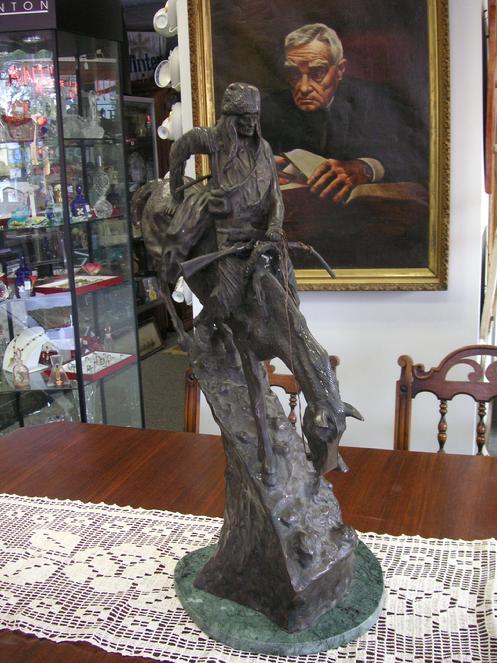 |
| The Mountain Man by Frederic Remington |
|
| |
Remington modeled and copyrighted "The Mountain Man" in 1903. For his subject he chose a dramatic episode in the life of a French Canadian trapper: his and his mount's descent on an almost vertical slope. Man and horse work together to make the trip down a treacherously rocky decline. The horse has been given full rein to choose its pace and path; the rider leans sharply back and balances himself by holding onto the tail strap with his right hand. The Museum's bronze was cast in 1907 in the lost-wax technique and was purchased, along with three other statuettes, directly from the artist. Relatively few casts of "The Mountain Man" were produced during Remington's lifetime; the number is thought to be about fifteen.
|
Thanks for stopping by today!
|
This website contains, in various sections, portions of copyrighted material not specifically authorized by the copyright owner. This material is used for educational purposes only and presented to provide understanding or give information for issues concerning the public as a whole. In accordance with U.S. Copyright Law Title 17 U.S.C. Section 107, the material on this site is distributed without profit. More Information
Information presented based on medical, news, government, and/or other web based articles or documents does not represent any medical recommendation or legal advice from myself or West Saint Paul Antiques. For specific information and advice on any condition or issue, you must consult a professional health care provider or legal advisor for direction.
I and West Saint Paul Antiques can not be responsible for information others may post on an external website linked here ~ or for websites which link to West Saint Paul Antiques. I would ask, however, that should you see something which you question or which seems incorrect or inappropriate, that you notify me immediately at floyd@weststpaulantiques.com Also, I would very much appreciate being notified if you find links which do not work or other problems with the website itself. Thank You!
Please know that there is no copyright infringement intended with any part of this website ~ should you find something that belongs to you and proper credit has not been given (or if you simply wish for me to remove it),
just let me know and I will do so right away.
|
Website Terms and Condition of Use Agreement
also known as a 'terms of service agreement'
By using this website, West Saint Paul Antiques . Com, you are agreeing to use the site according to and in agreement with the above and following terms of use without limitation or qualification. If you do not agree, then you must refain from using the site.
The 'Terms of Use' govern your access to and use of this website and facebook pages associated with it. If you do not agree to all of the Terms of Use, do not access or use the website, or the facebook sites. By accessing or using any of them, you and any entity you are authorized to represent signify your agreement to be bound by the Terms of Use.
Said Terms of Use may be revised and/or updated at any time by posting of the changes on this page of the website. Your continued usage of the website, or the facebook site(s) after any changes to the Terms of Use will mean that you have accepted the changes. Also, any these sites themselves may be changed, supplemented, deleted, and/or updated at my sole discretion without notice; this establishes intellectual property rights by owner (myself).
It saddens me to include a Terms of Use for West Saint Paul Antiques . Com, but we all realize it is something that is necessary and must be done these days. By using the website, or facebook for West Saint Paul Antiques, you represent that you are of legal age and that you agree to be bound by the Terms of Use and any subsequent modifications. Your use of the West Saint Paul Antiques sites signify your electronic acceptance of the Terms of Use and constitute your signature to same as if you had actually signed an agreement embodying the terms.
|
|